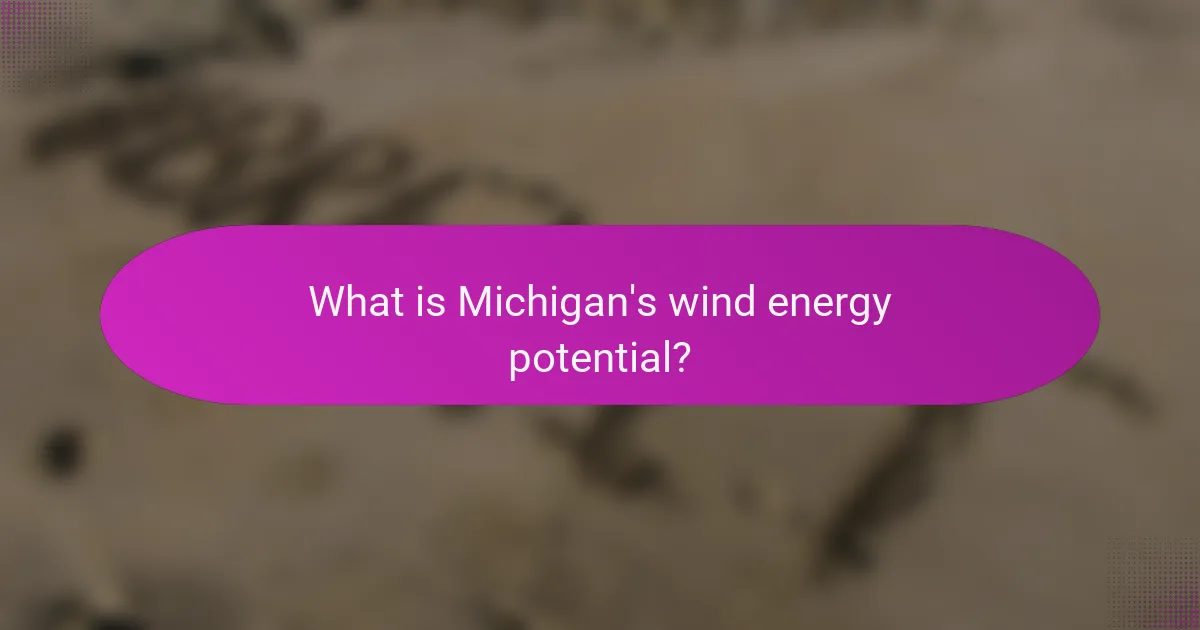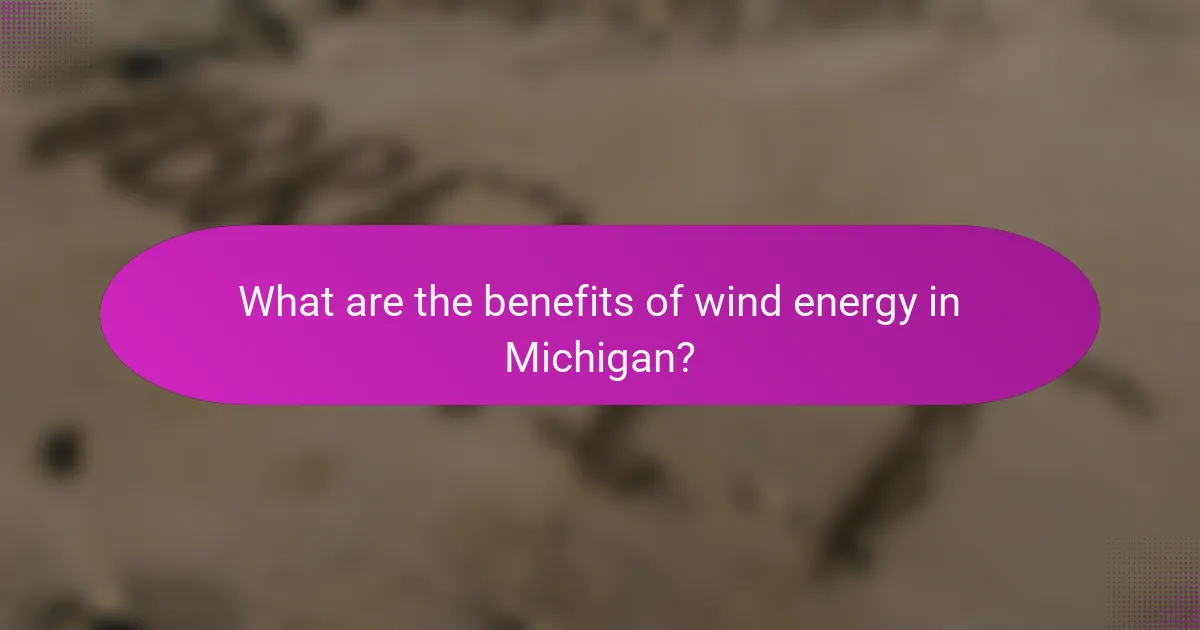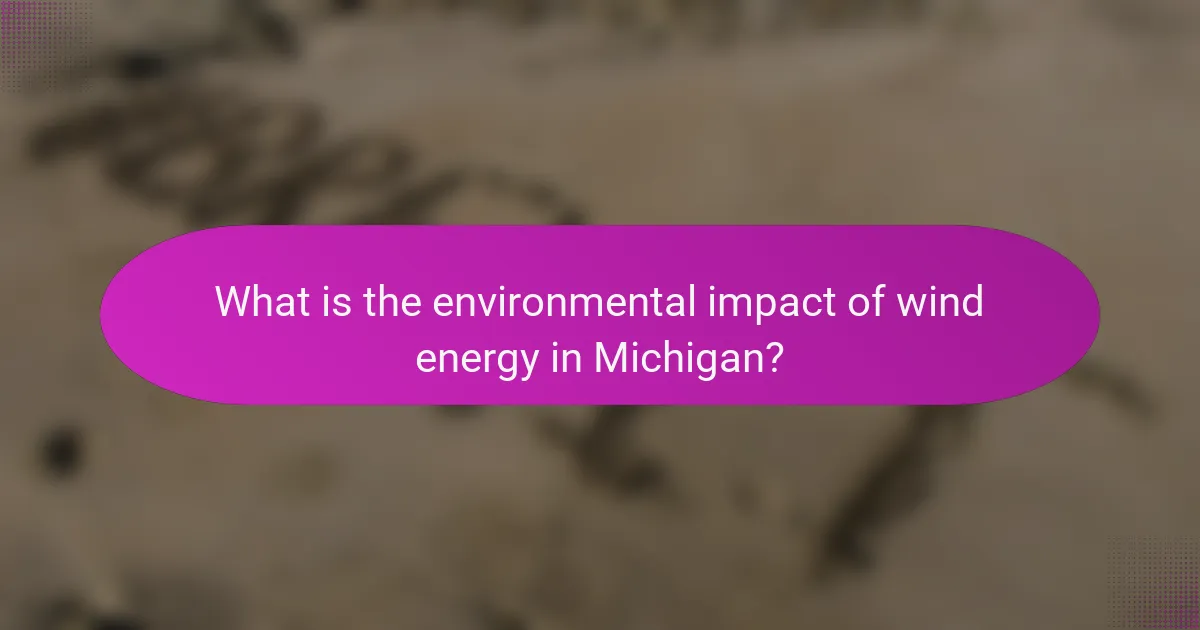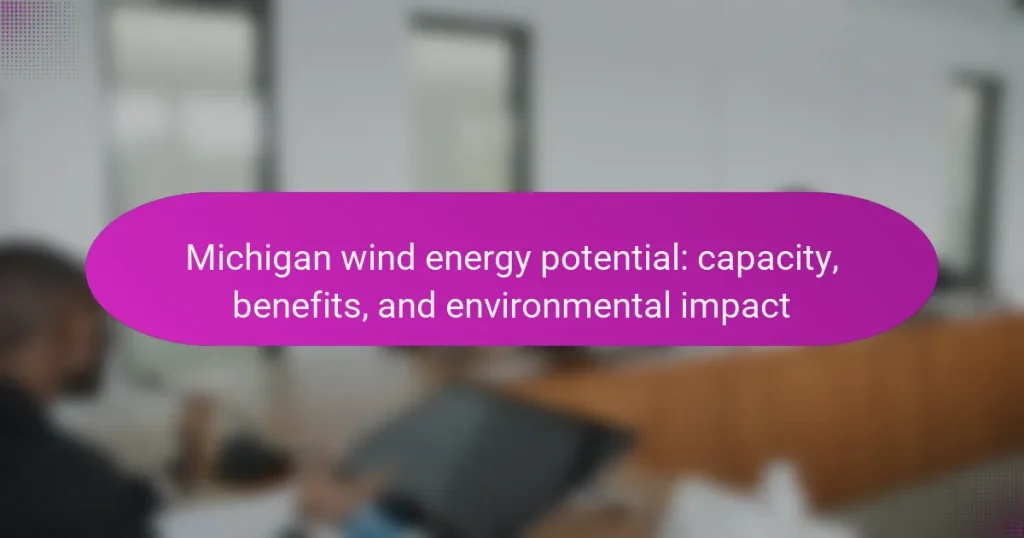
What is Michigan’s wind energy potential?
Michigan’s wind energy potential is significant, with the state having an estimated capacity of over 10,000 megawatts. This potential is based on the state’s geographical features and wind patterns. The Great Lakes region provides favorable conditions for wind energy generation. According to the U.S. Department of Energy, Michigan ranks among the top states for onshore wind energy potential. The state has already harnessed some of this potential, with over 2,500 megawatts installed as of 2021. Projections indicate that Michigan could meet a substantial portion of its energy needs through wind power. The continued development of wind energy infrastructure is expected to enhance this potential further.
How is wind energy capacity measured in Michigan?
Wind energy capacity in Michigan is measured in megawatts (MW). This metric reflects the maximum output a wind turbine or wind farm can produce under optimal conditions. The capacity is determined by factors such as turbine size, wind speed, and the number of turbines installed. Michigan has an estimated wind energy capacity of over 2,000 MW. This capacity is assessed through wind resource maps and data collected from meteorological towers. The capacity factor, which indicates the actual output versus the maximum potential, is also considered in evaluations.
What are the key metrics for assessing wind energy capacity?
The key metrics for assessing wind energy capacity include capacity factor, wind speed, and turbine efficiency. Capacity factor measures the actual output versus the potential output of a wind turbine over time. It is typically expressed as a percentage. Wind speed is crucial, as higher average speeds correlate with increased energy production. Turbine efficiency indicates how effectively a turbine converts wind energy into electrical energy.
Additional metrics include the number of turbines, rotor diameter, and height of the turbine. The number of turbines installed affects the total energy output. Rotor diameter influences the area swept by the blades, impacting energy capture. The height of the turbine determines the wind resource available, as wind speeds generally increase with altitude.
These metrics are vital for evaluating the performance and feasibility of wind energy projects, particularly in regions like Michigan, where wind patterns significantly impact energy potential.
How does Michigan’s wind energy capacity compare to other states?
Michigan ranks 13th in the United States for wind energy capacity. As of 2023, Michigan has an installed capacity of approximately 3,300 megawatts. This places it behind states like Texas, Iowa, and Oklahoma, which lead in capacity. Texas, for example, has over 30,000 megawatts of wind energy capacity. Michigan’s wind energy growth has been significant, with a 15% increase in capacity from 2021 to 2022. The state’s favorable wind conditions contribute to its potential for further development.
What factors influence wind energy potential in Michigan?
The factors that influence wind energy potential in Michigan include wind speed, terrain, and proximity to transmission lines. Wind speed is crucial; higher average speeds typically lead to greater energy generation potential. Michigan has varying wind speeds across regions, with areas like the Thumb region showing optimal conditions. Terrain also affects wind patterns; flat or elevated areas can enhance wind flow. Additionally, the distance to transmission lines impacts the feasibility of energy distribution. The availability of infrastructure can either facilitate or hinder the development of wind energy projects.
How do geographical features affect wind energy generation?
Geographical features significantly impact wind energy generation. Features such as mountains, valleys, and bodies of water can influence wind patterns. Mountains can block or redirect wind flow, creating turbulence. Valleys may funnel winds, increasing their speed in specific areas. Open plains typically allow for more consistent wind speeds. Proximity to large bodies of water can moderate temperatures and influence local wind patterns. According to the National Renewable Energy Laboratory, wind speeds are crucial for energy generation, with higher speeds leading to greater energy output. Therefore, understanding geographical features is essential for optimizing wind energy projects.
What role do climate conditions play in wind energy potential?
Climate conditions significantly influence wind energy potential. Wind energy generation depends on wind speed, direction, and consistency. Regions with higher average wind speeds produce more energy. For instance, areas with sustained winds of 6.4 to 9.3 meters per second are ideal for wind farms. Seasonal variations also affect wind patterns. In Michigan, winter months often have stronger winds, enhancing energy production during this period. Additionally, terrain and surface roughness can alter wind flow. Studies show that locations with fewer obstructions yield higher wind speeds. Therefore, understanding local climate conditions is crucial for optimizing wind energy generation.

What are the benefits of wind energy in Michigan?
Wind energy in Michigan provides several significant benefits. It contributes to reducing greenhouse gas emissions. This renewable energy source helps decrease reliance on fossil fuels. Wind energy also supports local economies through job creation. In 2020, the wind sector employed over 6,000 people in Michigan. Additionally, wind energy can lower electricity costs for consumers. The state has an estimated potential of over 200,000 megawatts of wind energy capacity. This potential can enhance energy security and stability. Overall, wind energy represents a sustainable solution for Michigan’s energy needs.
How does wind energy contribute to Michigan’s economy?
Wind energy significantly contributes to Michigan’s economy by creating jobs and generating revenue. The industry has led to the establishment of over 25,000 jobs in manufacturing, installation, and maintenance. In 2020, wind energy projects generated approximately $1.6 billion in economic activity. This includes investments in local communities and infrastructure. Additionally, wind farms provide land lease payments to farmers, enhancing agricultural income. The state benefits from increased tax revenues, which support public services. Furthermore, wind energy reduces electricity costs for consumers, contributing to overall economic savings.
What jobs are created by the wind energy sector?
The wind energy sector creates various jobs across multiple categories. These jobs include turbine manufacturing positions, which involve producing components like blades and towers. Installation jobs are essential for setting up wind turbines on-site. Maintenance roles are critical for ensuring the turbines operate efficiently over their lifespan. Additionally, project management positions oversee the development and execution of wind energy projects. According to the U.S. Department of Energy, the wind sector employed over 114,000 workers in 2019, demonstrating significant job creation potential. This figure highlights the sector’s capacity to provide stable employment opportunities in both rural and urban areas.
How does wind energy impact local communities financially?
Wind energy positively impacts local communities financially through job creation, tax revenue, and energy savings. The construction and maintenance of wind farms generate local employment opportunities. According to the American Wind Energy Association, wind projects can create an average of 1.5 permanent jobs for every megawatt of installed capacity. Additionally, wind energy projects contribute significantly to local tax bases. These projects can provide millions in property tax revenue, which supports local schools and infrastructure. Furthermore, residents can benefit from lower energy costs due to the increased availability of renewable energy. A study by the National Renewable Energy Laboratory found that wind energy can reduce electricity prices by 2-4% in regions with significant wind deployment. Overall, wind energy fosters economic growth within local communities.
What are the environmental benefits of wind energy?
Wind energy significantly reduces greenhouse gas emissions. It generates electricity without burning fossil fuels. This leads to a decrease in air pollutants such as carbon dioxide and sulfur dioxide. According to the U.S. Department of Energy, wind energy can prevent over 329 million metric tons of carbon dioxide emissions annually. Wind energy also conserves water. Unlike conventional power plants, wind turbines require no water for cooling. This is especially beneficial in arid regions where water scarcity is a concern. Additionally, wind energy promotes biodiversity. It can be developed on agricultural land, allowing for dual land use. Overall, wind energy contributes to a cleaner environment and supports sustainable development.
How does wind energy reduce greenhouse gas emissions?
Wind energy reduces greenhouse gas emissions by generating electricity without burning fossil fuels. Unlike coal or natural gas, wind turbines convert kinetic energy from wind into electrical energy. This process emits no carbon dioxide or other harmful pollutants. According to the U.S. Department of Energy, wind energy can reduce carbon emissions by over 330 million metric tons annually. This reduction is equivalent to the emissions of about 70 million cars. By displacing fossil fuel generation, wind energy contributes to cleaner air and a healthier environment.
What is the impact of wind energy on wildlife and ecosystems?
Wind energy can have both positive and negative impacts on wildlife and ecosystems. The construction and operation of wind farms can lead to habitat disruption for local species. Birds and bats are particularly vulnerable, as they may collide with turbine blades. Studies indicate that wind turbines can cause significant mortality rates among these animals. However, wind energy also contributes to reducing greenhouse gas emissions. This reduction can benefit ecosystems by mitigating climate change effects. Additionally, the land used for wind farms can sometimes support agriculture and wildlife habitats. Overall, the impact of wind energy varies by location and design of the wind farms.

What is the environmental impact of wind energy in Michigan?
Wind energy in Michigan has a positive environmental impact. It significantly reduces greenhouse gas emissions. Wind turbines generate electricity without burning fossil fuels. This leads to cleaner air and lower carbon footprints. Additionally, wind energy conserves water compared to conventional power generation. It uses minimal water for operations, unlike coal or natural gas plants. Studies indicate that wind energy in Michigan has helped avoid millions of tons of carbon dioxide emissions annually. The state has over 1,000 megawatts of installed wind capacity, contributing to these benefits. Overall, wind energy supports sustainability and mitigates climate change effects in Michigan.
What are the potential negative effects of wind energy installations?
Wind energy installations can have several potential negative effects. These include impacts on wildlife, particularly birds and bats, which may collide with turbine blades. A study by the U.S. Fish and Wildlife Service estimates that wind turbines kill approximately 140,000 to 328,000 birds annually in the U.S. Noise pollution is another concern, as turbines generate sound that can affect nearby residents. Research indicates that some individuals may experience sleep disturbances due to turbine noise. Additionally, the installation process can disrupt local ecosystems and habitats. Land use changes may result in habitat fragmentation, affecting local flora and fauna. Lastly, there are concerns about the visual impact of wind farms on landscapes, which can affect property values and local aesthetics.
How do wind turbines affect bird and bat populations?
Wind turbines negatively affect bird and bat populations primarily through collision and habitat disruption. Birds and bats can collide with turbine blades, leading to fatalities. Studies indicate that thousands of birds and bats die each year due to these collisions. For example, a 2013 study estimated that wind turbines caused approximately 573,000 bird deaths annually in the U.S. Additionally, the construction and operation of wind farms can alter habitats, impacting local wildlife. This habitat change can lead to reduced food availability and nesting sites for birds and bats. Consequently, while wind energy is a renewable resource, its impact on avian and chiropteran species must be carefully managed.
What measures are in place to mitigate environmental impacts?
Measures to mitigate environmental impacts include careful site selection for wind farms. This process assesses wildlife habitats and migratory paths. Additionally, technology advancements reduce noise and visual impacts. Environmental monitoring programs track effects on local ecosystems. Regular maintenance ensures efficient operation, minimizing unnecessary disruptions. Community engagement fosters transparency and addresses public concerns. These measures align with regulations set by the Michigan Department of Environment, Great Lakes, and Energy. Studies show that responsible wind farm management significantly lowers negative environmental effects.
How does the community perceive wind energy projects?
The community generally perceives wind energy projects positively, recognizing their environmental benefits. Many residents appreciate the reduction in greenhouse gas emissions associated with wind energy. Local surveys indicate that a significant portion of the community supports renewable energy initiatives. For example, a 2021 study by the Michigan Energy Innovation Business Council found that 70% of Michiganders favor wind energy development. However, some community members express concerns about noise and visual impacts. These concerns can lead to opposition in specific areas. Overall, the perception of wind energy projects in Michigan is largely favorable, with ongoing discussions about addressing local concerns.
What are common concerns among residents regarding wind energy?
Common concerns among residents regarding wind energy include noise, visual impact, and effects on wildlife. Residents often report that wind turbines generate significant noise, which can disrupt local peace. The visual presence of large turbines is also a concern, as they can alter the landscape and affect property values. Additionally, there are worries about the impact on local wildlife, particularly birds and bats, which may be harmed by turbine blades. Some studies indicate that wind farms can lead to habitat fragmentation, affecting local ecosystems. Concerns about safety, such as ice throw and structural failure, are also prevalent among residents. These issues can lead to opposition against wind energy projects in local communities.
How can community engagement improve wind energy projects?
Community engagement can improve wind energy projects by fostering local support and addressing concerns. Engaged communities are more likely to embrace renewable energy initiatives. This support can lead to smoother project implementation and fewer delays. Furthermore, community input can enhance project design to better fit local needs. For example, local feedback may influence turbine placement or project scale. Research shows that projects with strong community ties often experience increased operational success. According to a study by the National Renewable Energy Laboratory, community involvement can reduce opposition by over 50%. Thus, effective community engagement is crucial for the success of wind energy projects in Michigan.
What are the best practices for developing wind energy in Michigan?
The best practices for developing wind energy in Michigan include conducting thorough site assessments. This involves analyzing wind resources and environmental impacts. Engaging with local communities is essential for gaining public support. Adhering to state and federal regulations ensures compliance and sustainability. Implementing advanced technology enhances efficiency and reduces costs. Collaborating with research institutions can improve project outcomes. Securing funding through grants and incentives is crucial for financial viability. Finally, ongoing monitoring and maintenance are necessary to optimize performance. These practices contribute to successful wind energy projects in Michigan.
How can developers ensure minimal environmental impact?
Developers can ensure minimal environmental impact by implementing sustainable practices in their projects. This includes conducting thorough environmental assessments before construction. These assessments identify potential impacts on local wildlife and ecosystems. Developers should also utilize eco-friendly materials and technologies. For instance, using recyclable materials reduces waste and conserves resources. Additionally, selecting sites that minimize disruption to sensitive habitats is crucial. Developers can also engage with local communities to address concerns and incorporate feedback. Studies show that responsible planning can significantly reduce ecological footprints. For example, the National Renewable Energy Laboratory emphasizes the importance of site selection in minimizing environmental consequences.
What strategies can enhance community support for wind energy projects?
Engaging the community through education and transparency enhances support for wind energy projects. Providing clear information about project benefits, such as job creation and environmental impact, fosters trust. Hosting public forums allows residents to voice concerns and ask questions. Collaborating with local stakeholders ensures that community needs are prioritized. Offering financial incentives, like shared revenue models, can increase local buy-in. Demonstrating successful case studies from similar projects builds credibility. Regular updates on project progress keep the community informed and involved. Research shows that these strategies lead to higher acceptance rates for renewable energy initiatives.
Michigan’s wind energy potential is substantial, with an estimated capacity exceeding 10,000 megawatts, ranking the state among the top for onshore wind energy potential. The article explores how wind energy capacity is measured, the key metrics for assessment, and Michigan’s comparative standing with other states. It details the benefits of wind energy, including economic contributions and environmental advantages, while also addressing community perceptions and concerns regarding noise and wildlife impacts. Furthermore, best practices for sustainable development and strategies for enhancing community support are discussed, providing a comprehensive overview of Michigan’s wind energy landscape.

